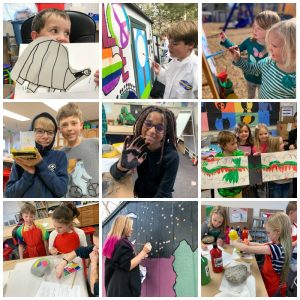
That thought-provoking headline comes from our Visual Arts Teacher, Christy Allen, who shared her thoughts on art – why we do it, what is is, and how we might consider practicing art even in these challenging times. Here are her insights. Stay tuned for Part Two, with tips on silencing self-criticism, getting started, and ideas to explore.
Art Does Not Require a Classroom
Well, let’s begin with this. Art does not require a classroom, nor does it require any particular material. We might be fooled into thinking art is housed inside something other than ourselves. I suppose it is, in a way. It is housed in our relationships, to the world outside of ourselves as well as inside of ourselves. Art does not, however, require any specific material, place, or technique. Perhaps, being stripped of these things, allow us a chance to discover this truth?
I think of art as a conversation, sometimes light and chatty, sometimes with a greater depth. This conversation, as I see it, is between an individual and their senses, emotions, and intellect. It’s between their desire to make conscious experience and to connect with other experiences, in order to more strongly feel their own. Simultaneously, and seemingly contradictory, it sometimes provides the sense of being outside of our individual self and connected to a greater whole.
Art as Conversation
This conversation can be had in many, many ways — almost any way. It can be through movement, through sound, through sight. It does not need even to be documented or made physical, like a painting, sheet of music, a film, or a meal. However, there does seem to be something primal in our desire to make art tangible, in our desire to share or somehow manifest our experience into a form separate from our own, an object of art.
It is wonderful to realize that wherever we sit now, as long as we have the ability to pay attention, art can be created. It is a living thing, an organic thing. However, despite the ever-present opportunity to create, it is not always easy. This kind of attention takes muscle and endurance. Even play takes energy! Art takes focus, concentration, perception and a desire to make experience conscious. And, yes, it takes courage.
Silencing the Critical Voices
It is in fact difficult, especially as we grow older, to keep the conversation going without being distracted by the rude interruptions from critical “outside” voices – voices that say things like, “A GOOD drawing is a drawing that physically resembles the thing you are observing.” That, I would respond, is mastering the technique of illusion which can be used, but should not be confused with what makes something “good.” Technique can be helpful and give us choices but, as anyone who has spent time around a young child knows, profoundly beautiful and perceptive thoughts can be communicated with a few simple words.
Poetry in Art
We can be wowed by a technique like, for example, photorealism, but even the most photorealistic works can be devoid of poetry – or they can contain poetry. I once heard a poet describe poetry as the action of banging two words together, like stones: the poetry is in the space between…the energy, the vibrations. The poetry is in the authenticity of the engagement and the realness of the conversation, that give life to the work. As an individual, this is the energy I am seeking when engaged in creating. As a teacher, I hope to help my students in discovering this energy.
Relief from Distraction
This time during which we are restricted to home has to a certain degree, relieved us from distraction. Perhaps right now the creative experience can be condensed down to the basics. These basics include: the moment; our thoughts, feelings, and sensations; the specific space we occupy, our desire to engage; and whatever may be at hand to document that engagement. We could use a piece of paper and a pencil, a leaf and a twig, water, a brush, and the sidewalk. There are endless tools.
We, all of us, parents and children alike, have all the ingredients we need at hand. Shall we enter the conversation with art and see where it takes us?
Stay tuned for Christy’s second article, here on this blog!
Curious about how our inquiry-based, cross-disciplinary approach that fully integrates the arts into our daily instruction? Learn more.
